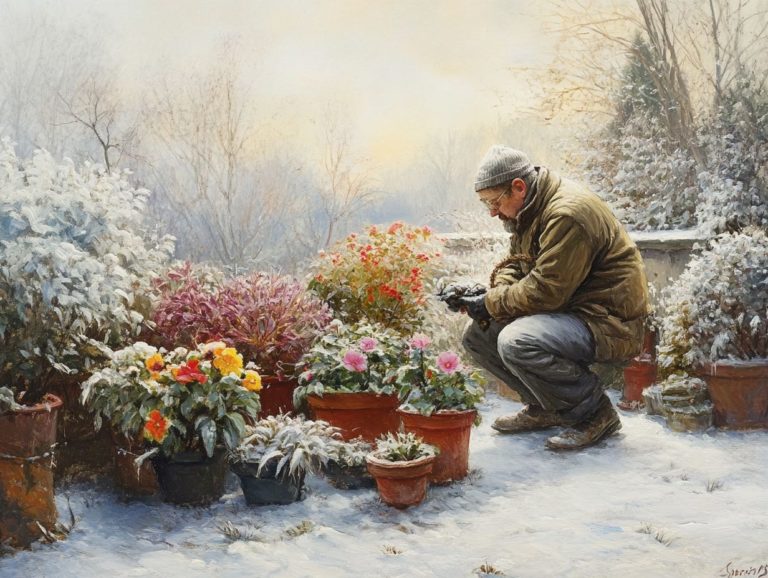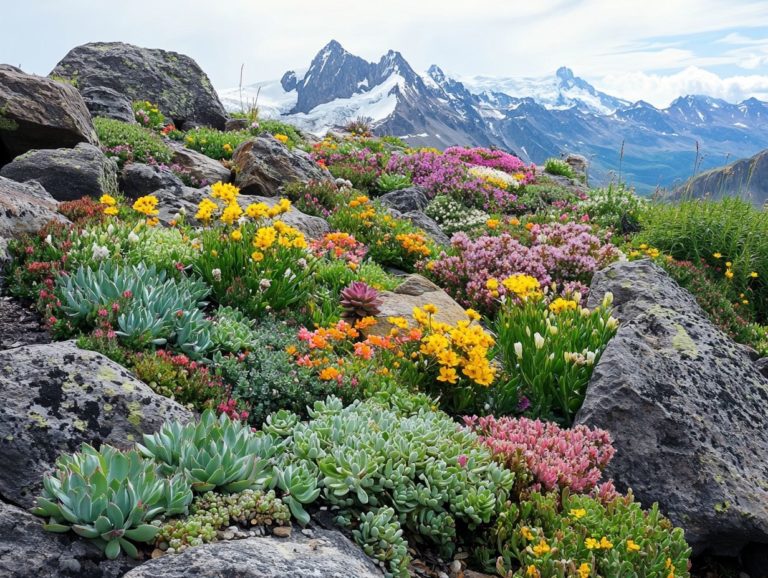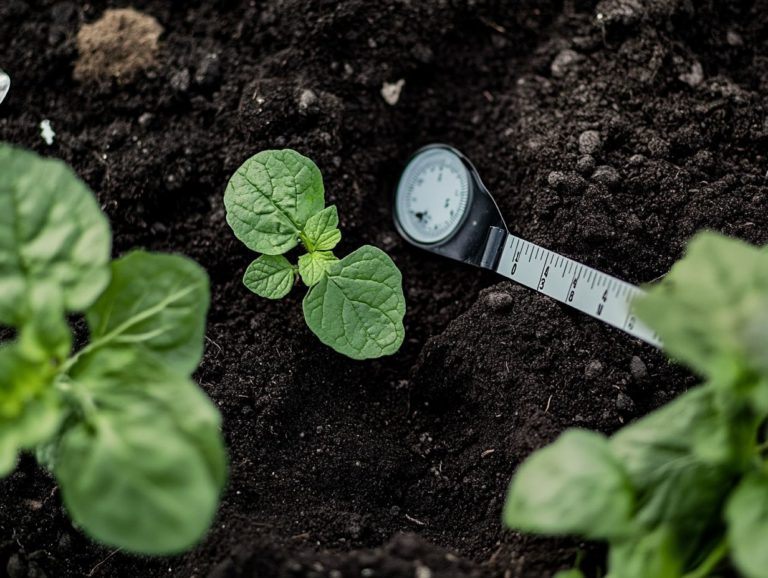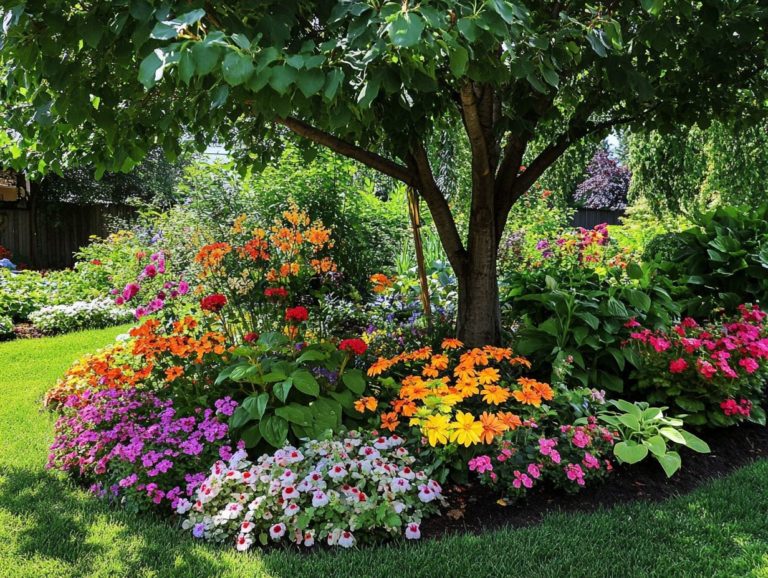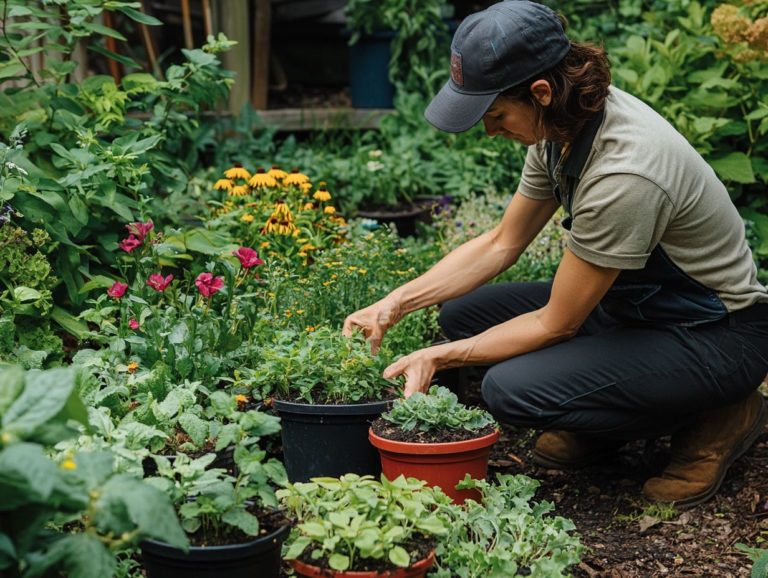Best Bulbs to Plant in Cold-Weather Gardens
As winter s chill begins to retreat, it s the ideal moment for you to enhance your garden with vibrant cold-weather bulbs.
From the cheerful blooms of tulips and daffodils to the delicate charm of snowdrops and crocuses, a colorful array of flowers awaits to brighten your landscape.
This guide will walk you through the best flower bulbs to plant for a breathtaking spring display, providing essential planting tips on preparation, care, and garden design to ensure your cold-weather planting flourishes.
Get ready to turn your garden into a vibrant oasis!
Contents
- Key Takeaways:
- 1. Tulips
- 2. Daffodils
- 3. Snowdrops
- 4. Crocuses
- 5. Hyacinths
- 6. Irises
- 7. Alliums
- 8. Fritillarias
- 9. Muscari
- 10. Glory of the Snow
- 11. Winter Aconite
- 12. Puschkinia
- 13. Siberian Squill
- 14. Grape Hyacinths
- 15. Cyclamen
- How to Prepare Your Garden for Cold Weather Bulbs
- Frequently Asked Questions about Bulb Bed Management
- What are the best bulbs to plant in cold-weather gardens, like gladiolus and ranunculus?
- When should I plant bulbs for a cold-weather garden?
- Is soil preparation necessary before planting bulbs in a cold-weather garden?
- What is the best planting depth for my bulbs?
- Do bulbs need to be watered during the winter in a cold-weather garden?
- Can I plant bulbs in containers for a cold-weather garden, following advice from experts like Bonnie Grant and Melanie Griffiths?
Key Takeaways:
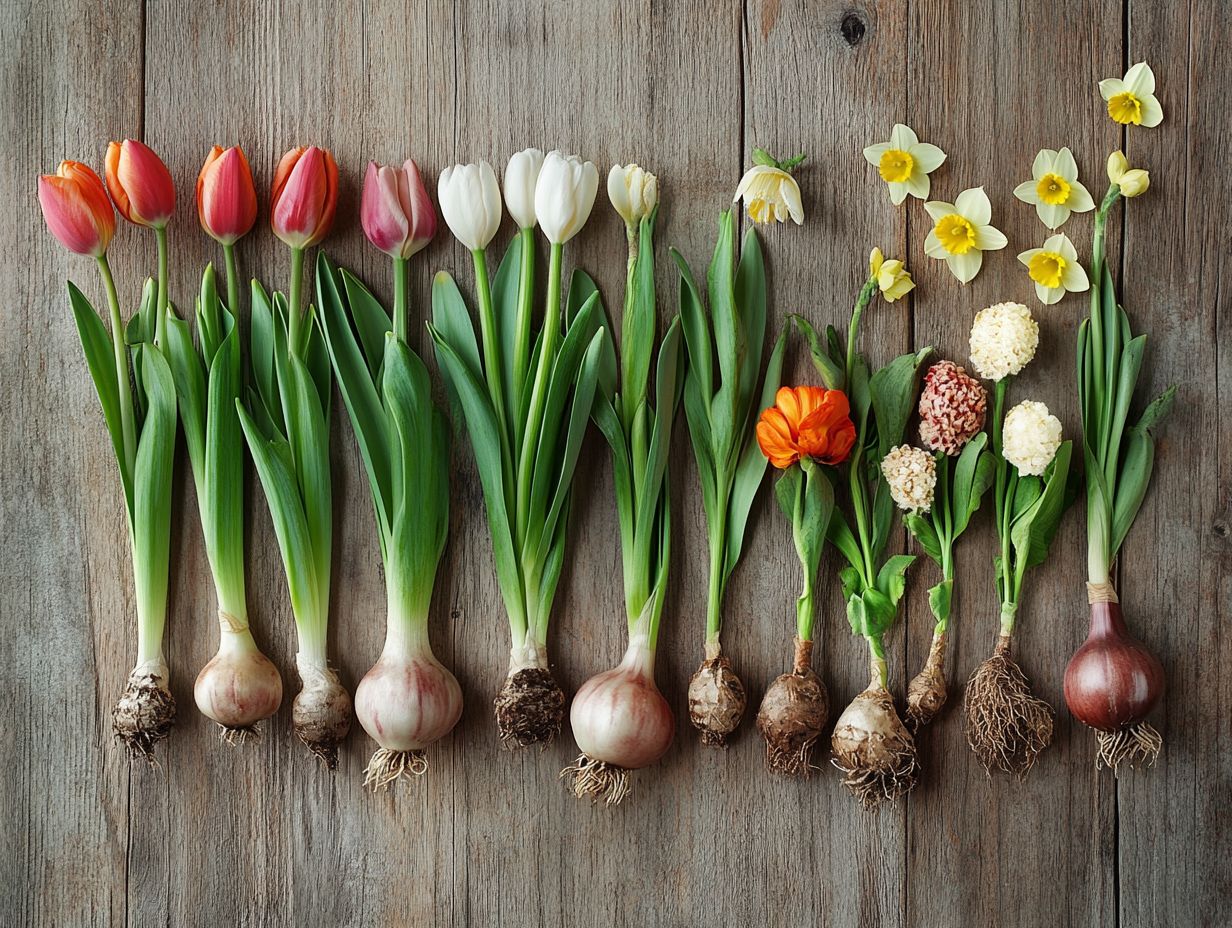
- Plant cold-weather bulbs like tulips and daffodils for a burst of color in your winter garden. Consider adding bluebells for additional charm.
- Prepare your garden by planting bulbs in well-drained soil and adding a layer of mulch for protection.
- Cold-weather bulbs need little care during winter and can naturalize to provide even more blooms in future years.
1. Tulips
Tulips are among the most cherished spring flowers, known for their beautiful colors and shapes. They are a staple in resilient spring gardens across various USDA zones, which are specific areas that determine which plants grow best in your environment. Thriving in cool climates, these flowering bulbs breathe vibrant life into your garden after the long winter frost.
You ll find many varieties, like the robust Darwin Hybrids, known for their sturdy stems and long-lasting blooms, or the compact Triumph tulips, ideal for crisp borders. When planting, select a sunny spot to foster healthy growth. Water them every few weeks after planting, and they ll reward your efforts from early to late spring, depending on the variety.
For an impressive bulb garden, blend tulips with other perennial flowers like daffodils or hyacinths. This combination will create a continuous display of color, ensuring that each bloom complements the next.
2. Daffodils
Daffodils, with their cheerful yellow blooms, are a true hallmark of spring gardens. They symbolize renewal and hope, emerging as one of the first flower bulbs from the cold soil, making them perfect for your cool climate and USDA zones.
You’ll find numerous varieties, each showcasing unique traits. For example, the classic ‘King Alfred’ grabs attention with its large, bright yellow petals, while ‘Ice Follies’ impress with their radiant white blooms and golden centers.
When planting daffodils, choose a location with well-drained soil and ample sunlight. Fall is the ideal time to plant before the ground freezes. After planting, a light mulch will help retain moisture and keep pesky weeds at bay.
To ensure healthy blooms come spring, remember to water regularly during dry spells and fertilize with a balanced bulb food. This will boost growth, so act now!
3. Snowdrops
Snowdrops are enchanting spring flowers, often blooming even amidst winter’s chill, heralding the arrival of spring with their delicate white petals. They quickly become a favorite among gardeners, particularly in colder climates.
Their ability to thrive in harsh conditions adds beauty to your garden and provides a vital early food source for pollinators. For optimal care, these resilient flowers prefer well-drained soil and thrive in partial shade, making them versatile companions for various garden designs.
By planting snowdrops alongside hardy spring bulbs like crocuses and daffodils, you can create a stunning display of colors and textures that enhances the overall appeal of your bulb garden. Their early bloom time, combined with modest height, allows them to gracefully complement the taller flowers that bloom later in the season.
Ready to see your garden burst into color? Start planting today and watch your garden come alive!
4. Crocuses
Crocuses are the vibrant heralds of spring, emerging early in the season and often piercing through lingering snow. Their striking colors and resilience in cooler climates make them an essential addition to any flower bulb collection.
You’ll love the variety of colors these stunning blooms bring! These hardy perennials come in a delightful array of species, each flaunting its own unique hues and patterns, from delicate whites and soft yellows to rich purples and bold striped varieties. When you plant them, ensure you choose well-drained soil and a sunny spot.
They thrive in bulb gardens, where their cheerful blooms can be woven among other spring flowers, creating a captivating tapestry of colors. Consider naturalizing these charming flowers in your lawn or beneath deciduous trees. This approach guarantees a delightful display that welcomes the arrival of spring, attracting both pollinators and admirers alike.
5. Hyacinths
Hyacinths are the fragrant jewels of spring, transforming gardens with their vibrant colors and enchanting scents. If you’re seeking to elevate your bulb gardens and entice pollinators during those blossoming months, these flowers should definitely be on your radar.
You’ll love the variety of colors these stunning blooms bring! These exquisite flowers offer a delightful array of varieties, from the classic Dutch Hyacinth, showcasing a spectrum of colors from deep blue to lively pink to the woodland Hyacinth, celebrated for its delicate charm and softer hues.
To thrive, hyacinths prefer well-drained soil and a sunny spot, making them perfect for flower beds or borders. Remember to water them regularly, especially during dry spells. Be cautious not to let them sit in water.
You can even weave them into your edible landscaping; their flowers are not only beautiful but also edible, adding a unique twist to your salads. Plus, the bulbs can be harvested for certain gourmet dishes, beautifully blending aesthetics with functionality in your garden.
6. Irises
Irises are breathtaking spring flowers, celebrated for their intricate shapes and vibrant colors. They ve earned a special place in the hearts of gardeners looking to craft stunning bulb gardens that thrive in cooler climates.
These perennial beauties come in various types, each with its own unique growing requirements tailored to a range of growing zones. For example, rhizomatous irises thrive in well-drained soil and sun-drenched spots, flourishing best in zones 3 to 9.
On the flip side, bearded irises boast magnificent blooms and sturdy stems. They favor similar conditions but also benefit from good air circulation to ward off rot.
Meanwhile, Louisiana and Siberian irises are your go-tos for wetter environments, making them perfect for zones 3 to 10. To cultivate a flourishing iris garden, you ll want to plant them at the correct depth and ensure ample spacing.
Regular deadheading (removing wilted flowers to encourage new blooms) and mulching (adding a protective layer on soil) will also be key to protecting their precious roots.
7. Alliums

Alliums are truly striking spring flowers that bring a unique spherical charm to your bulb gardens. They elevate the architectural interest and showcase an exceptional display during the spring season in growing zones.
Their rich palette, ranging from deep purples to delicate whites, creates a stunning contrast when you strategically intersperse them with other flowering bulbs. Consider species like Allium giganteum, known for its impressive height and large globe-shaped flowers; they can effortlessly serve as focal points in your garden.
Meanwhile, lower varieties such as Allium moly are perfect for providing ground cover and filling those pesky gaps. To enhance their growth, focus on proper care practices, ensuring well-draining soil and ample sunlight.
You can create harmonious layouts by pairing alliums with tulips or daffodils, weaving together a vibrant visual tapestry that captivates anyone who strolls through your garden. Plant these beauties today to brighten your spring!
8. Fritillarias
Fritillarias are exotic spring flowers that add a unique flair to any garden. Their distinctive shape and vibrant colors make them a highly sought-after addition to hardy spring bulb collections.
Among the many varieties, you’ll find the Fritillaria imperialis, renowned for its regal crown of flowers. This beauty thrives in well-drained soil and full sunlight.
On the other hand, the Fritillaria meleagris charms with its delightful checkered patterns, preferring partial shade and moist conditions.
To ensure successful growth in cooler climates, it’s essential to plant these bulbs at the right depth, typically about six inches for the larger varieties. Additionally, choosing cold-hardy flowers for your garden and protecting them from harsh winter winds with layers of mulch is crucial.
Regular watering during dry spells will promote their vitality, allowing these stunning blooms to flourish as they herald the arrival of spring.
9. Muscari
Muscari, often referred to as grape hyacinths, are delightful spring flowers that effortlessly produce clusters of enchanting, bell-shaped blooms. With ease, they can transform your bulb garden into a stunning carpet of color.
These charming plants thrive in well-drained soil and bask in full to partial sun, requiring minimal care. They are ideal for even the most novice gardeners.
The vibrant blue, purple, or white hues of muscari create a striking contrast when paired with early bloomers like daffodils and tulips, enriching the overall aesthetic of your landscape.
They have a wonderful ability to spread naturally over time, meaning once you plant them, they ll multiply and grace your garden year after year. This delivers a low-maintenance burst of color that heralds the arrival of spring.
By incorporating muscari into your garden design, you can genuinely elevate the beauty and joy of the season, ensuring a foundation for your bulb gardens to thrive.
10. Glory of the Snow
Glory of the Snow is a delightful spring flower that makes its entrance early in the season, often showcasing its star-shaped blooms even while snow lingers. This proves to be a resilient choice for your cold-weather garden.
Not only does it enchant with its vibrant hues of blue, pink, or white, but this perennial bulb also thrives in well-drained soil and requires minimal care once it’s established.
It’s perfect for rock gardens and makes great ground cover. Planting these bulbs in clusters will amplify their visual appeal.
To create a stunning bulb bed, consider layering them among other early bloomers. This will allow for a cascading effect of colors as spring unfolds.
By ensuring they receive ample sunlight and giving them a drink during dry spells, you can watch these hearty flowers thrive, providing a splendid welcome to the season.
11. Winter Aconite
Winter aconite is an enchanting early-blooming spring flower that brings a vibrant splash of yellow to your garden, often emerging through the snow. It’s a favored choice for those looking to elevate their hardy spring displays.
For optimal growth, this charming perennial flourishes in well-draining soil and prefers a spot that enjoys partial to full shade, much like its natural woodland habitat.
Proper care involves regular watering especially during dry spells but be cautious to avoid waterlogging, as that can lead to root rot.
Once it’s established, winter aconite demands minimal maintenance, allowing you to revel in its beauty without excessive effort.
Not only does this stunning flower stand out on its own, but it also harmonizes beautifully with other early bloomers like snowdrops and crocuses. Together, they create a delightful tapestry of color that joyously announces the arrival of spring.
12. Puschkinia
Puschkinia, or striped squill, is a delightful spring flower that graces your garden with its delicate blue and white blossoms. It makes a stunning addition to any bulb collection in cool climate areas.
This charming plant thrives in well-drained soil and prefers partial sunlight, offering you the flexibility to incorporate it into various garden settings.
When considering companions, pair it with vibrant daffodils or cheerful tulips. This not only elevates the visual allure but also extends the blooming period, creating a colorful tapestry against the backdrop of lush green foliage.
Its low growth habit makes puschkinia an excellent choice for the front of borders or even as ground cover, allowing it to enchant onlookers while seamlessly blending into your diverse planting schemes.
13. Siberian Squill
Siberian squill is a resilient spring flower. It graces your garden with charming blue blooms, often carpeting the ground in early spring.
For gardeners in cold weather regions, it s an absolute must-have. The vibrant color not only signals the arrival of spring but also creates a breathtaking contrast against the emerging greens.
Pair it with edible landscaping options for a stunning effect. To achieve the best results, be sure to plant the bulbs in well-drained soil in a spot that enjoys partial to full sunlight.
Regular watering during dry spells promotes healthy growth. A light mulch can safeguard the bulbs from temperature fluctuations.
Incorporating Siberian squill into your flower designs enhances visual interest and attracts pollinators, fostering a lively garden ecosystem. With minimal maintenance required, this delightful plant offers a rewarding way to embrace the changing season.
14. Grape Hyacinths
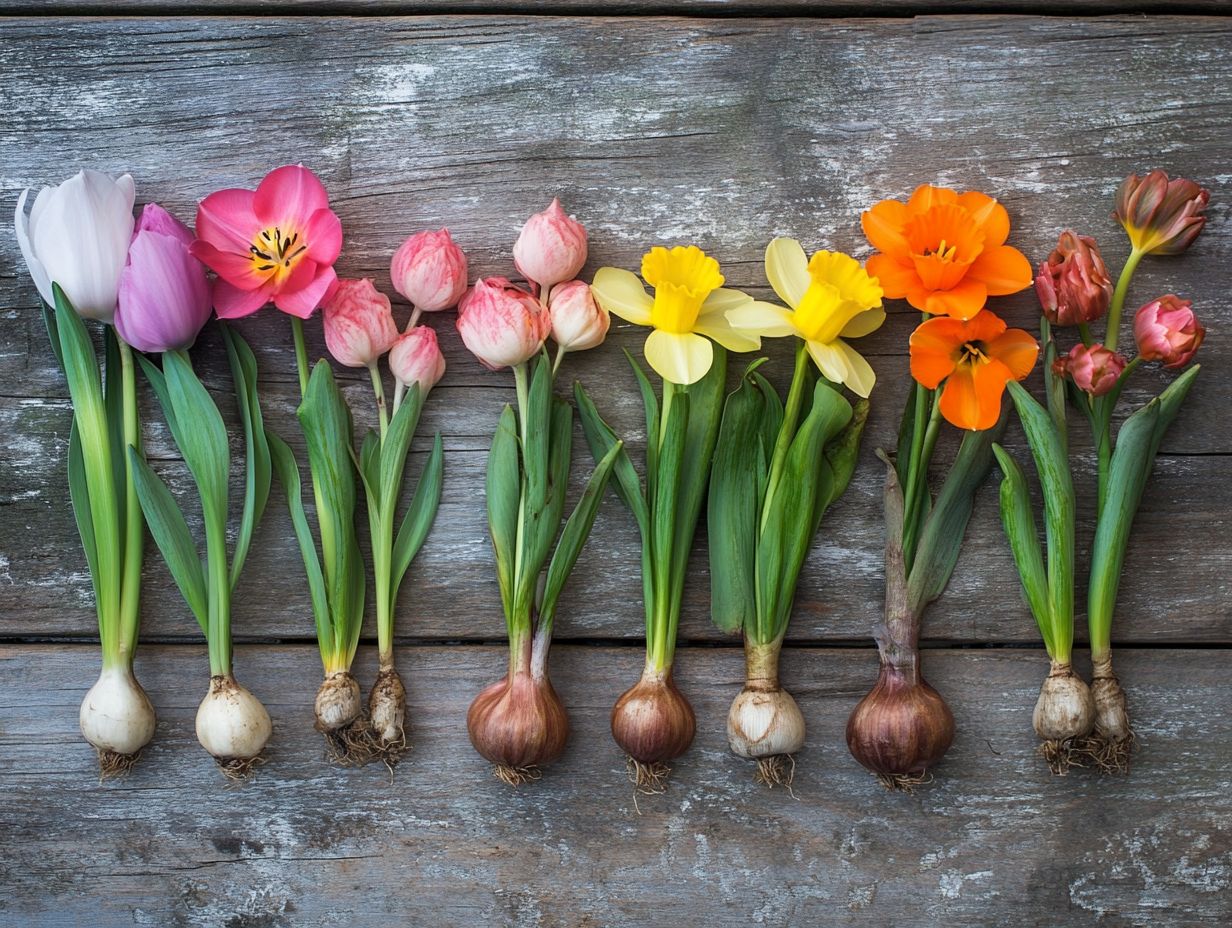
Grape hyacinths are essential spring flowers, charming you with their striking clusters of small, bulbous blooms that create a delightful spectacle in your garden.
Planting them en masse is a sure way to achieve a stunning effect that captures attention. These delightful little plants can reach heights of six to twelve inches, forming lovely hummocks in shades of blue, violet, or white.
They re perfect for garden beds or mixed with other perennial bulbs, offering vibrant contrasts against daffodils, tulips, or even later-blooming flora.
For planting, choose a well-drained area and ensure they bask in ample sunlight to thrive. Care includes watering during dry spells and deadheading spent blooms to extend their flowering period.
Incorporating grape hyacinths into your existing bulb gardens elevates the visual appeal, adding depth and texture while weaving a rich tapestry of colors as the seasons gracefully transition.
15. Cyclamen
Cyclamen bring magic to your spring garden with their unique blooms. They thrive in shady areas, offering beautifully shaped flowers that elevate your spring displays.
These captivating plants flourish in well-drained soil and prefer cooler temperatures, making them perfect companions for spots under trees or along shaded pathways.
To ensure their vibrant colors endure, manage watering with precision; keep the soil moderately moist but steer clear of over-saturation.
Cyclamen can harmonize beautifully with other spring blossoms, like daffodils and hyacinths, contributing to a layered design that captivates the eye.
When perfectly positioned, they create an enchanting scene, seamlessly adding texture and elegance to your garden space, reminding all who gaze upon them of the understated beauty of nature.
How to Prepare Your Garden for Cold Weather Bulbs
Preparing your garden for cold weather bulbs requires a few essential steps. Start by selecting the right planting location based on your USDA zone (a classification that helps you understand what plants thrive in your area), including plants that bloom early in cold weather.
Make sure the soil is well-drained to support healthy growth throughout the winter.
- Begin by conducting a soil test to assess its pH and nutrient levels. This will inform any necessary amendments you may need to make.
- Choose a sunny spot that receives at least six hours of light each day to maximize blooming potential.
- Enhance drainage by incorporating organic matter, such as compost, to prevent waterlogging that could lead to bulb rot.
- When planting, position the bulbs at the recommended depth, typically two to three times their height, and group them in clusters for a more striking display.
- Finally, consider mulching with organic materials to help regulate temperature and moisture, creating an ideal environment for your bulbs to thrive during the colder months.
Don’t wait too long to plant these beauties! They ll transform your garden as soon as spring arrives.
What Are the Best Planting Techniques for Cold-Weather Bulbs?
To master the art of planting cold-weather bulbs, focus on selecting the right depth for each bulb species, such as tulips or daffodils. Additionally, consider the best plants for windy cold-climate gardens to ensure proper spacing and utilize mulching techniques to conserve moisture and shield against temperature fluctuations.
Daffodils typically thrive when planted 6 to 8 inches deep, while tulips prefer a slightly shallower depth of 6 to 7 inches. This allows their roots to establish effectively.
In terms of spacing, larger bulbs like alliums should be planted about 8 inches apart. Smaller varieties, such as crocuses, can be planted closer together at about 3 to 4 inches apart.
Soil preparation is crucial opt for a well-draining mix enriched with compost to boost growth. Don’t overlook the power of mulch; it retains moisture and serves as a protective barrier, reducing the risk of frost heave during unpredictable winter spells.
How to Care for Cold-Weather Bulbs During the Winter Months?
Caring for your cold-weather bulbs in winter is essential for their health and achieving stunning blooms in spring. This involves keeping an eye on soil moisture, applying mulch, and selecting plants for a winter garden to protect them from harsh cold conditions.
By monitoring moisture levels in the soil, you can provide just the right amount of water without oversaturating. Too much moisture can lead to rot. Mulch is your best friend here; it regulates temperature and retains soil dampness, acting as a cozy blanket that insulates delicate bulbs.
Consider placing windbreaks or using row covers for extra protection against biting winter winds. These measures can prevent soil from freezing too deeply, ensuring your precious plants survive the frost and awaken vibrantly when spring arrives.
What Are the Benefits of Planting Cold-Weather Bulbs?
Planting cold-weather bulbs offers many advantages, including early spring blooms that illuminate your garden. For those looking to enhance their outdoor space, consider the top 10 perennials for cold-weather gardens, which thrive in cool climate areas and provide stunning displays of gladiolus and ranunculus.
These resilient plants bring vibrant colors and various options to complement any style. They also support local ecosystems, including edible landscaping. By attracting early-season pollinators like bees and butterflies, they enrich the health of your garden environment.
Their timely emergence extends your gardening season, allowing you to enjoy your efforts even before summer’s warmth arrives. This proactive approach elevates the visual appeal of your landscape and fosters biodiversity, creating a thriving habitat for diverse wildlife.
How to Incorporate Cold-Weather Bulbs into Your Garden Design?
Incorporating cold-weather bulbs into your garden design requires thoughtful planning, especially when considering specific areas that indicate suitable planting conditions (USDA zones). To enhance your garden, consider using the best plants for cold-climate wildflower gardens, and think about layering bulbs for continuous blooms with varieties like hyacinth and crocus.
By selecting bulb types that bloom at different times, you can create a stunning progression of colors from early spring to summer blooms. For instance, vibrant crocuses peeking through the snow beautifully set the stage for lush daffodils and elegant tulips later in the season.
When envisioning the layout, place taller varieties like tulips and iris at the back and shorter ones such as daffodils and anemone in front. This maximizes visibility and adds depth to your garden.
Mixing contrasting colors, such as deep purples with bright yellows, injects excitement and energy into your design, inviting the eye to explore every corner of the blooming space.
Frequently Asked Questions about Bulb Bed Management

What are the best bulbs to plant in cold-weather gardens, like gladiolus and ranunculus?
Some of the best bulbs to plant include tulips, daffodils, crocuses, hyacinths, snowdrops, and alliums, especially when following top tips for planting cold-weather bulbs.
When should I plant bulbs for a cold-weather garden?
Plant your bulbs soon to ensure a spectacular spring display! Ideally, bulbs should be planted in the fall, at least six weeks before the first frost.
Is soil preparation necessary before planting bulbs in a cold-weather garden?
Preparing the soil is crucial. Mix in compost or other natural materials to ensure it drains well, helping the bulbs thrive in cold weather. Consider planting the best cold-hardy vegetables for winter gardens to maximize your garden’s potential.
What is the best planting depth for my bulbs?
For optimal growth, plant bulbs at a depth of 2-3 times their height. For example, if a bulb is 2 inches tall, it should be planted 4-6 inches deep.
Do bulbs need to be watered during the winter in a cold-weather garden?
No, bulbs do not need watering in winter. They are dormant and will get enough moisture from melting snow and rain.
Can I plant bulbs in containers for a cold-weather garden, following advice from experts like Bonnie Grant and Melanie Griffiths?
Absolutely! Just ensure the container is large enough for the bulbs and has good drainage.

